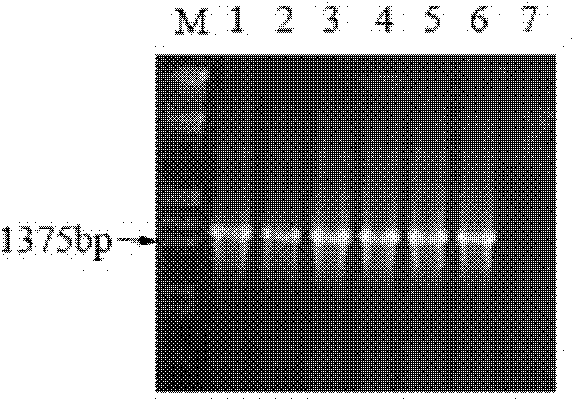Preparation method and application of brassica napus BnPABP5-3 promoter
A Brassica napus and promoter technology, applied in the field of plant genetic engineering and biology, can solve problems such as unsuitable production practice, unfavorable normal growth of plants, and harmful ecological environment
- Summary
- Abstract
- Description
- Claims
- Application Information
AI Technical Summary
Problems solved by technology
Method used
Image
Examples
Embodiment 1
[0044] A kind of Brassica napus P BnPABP5-3 The preparation method of the promoter, its steps are:
[0045] A, rape P BnPABP5-3 Promoter primer design:
[0046] Use SDS lysis method to extract rapeseed DNA (by J. Sambrook. DW Russell, Huang Peitang et al. Translated Molecular Cloning Test Guide (Third Edition) Science Press), according to the Genome Walking Kit (purchased from Clontech, product Code Cat.No.638904) operation program, carry out genome walking, walking carry out two rounds of PCR amplification, clone and obtain rape P BnPABP5-3 (942bp). The primers used for walking are shown in Table 2.
[0047] Table 2 Genome walking clone P BnPABP5-3 Primer used
[0048]
[0049] B. Brassica napus P BnPABP5-3 The promoter preparation is:
[0050] According to the instructions of the Genome Walking Kit (purchased from Clontech, product code Cat.No.638904), approximately 2.5μg of DNA were digested with the restriction enzymes DraI, EcoRV, PvuII and StuI to produce blunt ends in 100μl sys...
Embodiment 2
[0054] pBI-P BnPABP5-3 Arabidopsis transformation and PCR detection:
[0055] According to the above-mentioned document (Zhang X R. et al. Agrobacterium-mediated transformation of Arabidopsis thaliana using the floral dip method. Nature, 2006, 1:1-6) the transformation method of Arabidopsis thaliana was transformed. According to the unique kanamycin resistance of the transgenic plants, they were grown on MS (described above) medium containing 50 mg / L kanamycin, and the green shoots obtained were initially considered to be positive shoots. After the green seedlings grow two true leaves, they are transplanted into vermiculite. After the plants appear inflorescence, one true leaf is taken to extract genomic DNA (described above) by the SDS method, and PCR identification is performed. The primer sequences are 5'-GAATTGTGAGCGGATAAC-3' and 5'-ACATAAGGGACTGACCAC-3'; the PCR reaction system is as follows: Genomic DNA template 1μL (about 50ng), 10×Taq enzyme reaction buffer 2ul, 25mMMgCL ...
Embodiment 3
[0057] Brassica napus P BnPABP5-3 Functional analysis of the promoter:
[0058] The present invention clones P for the first time BnPABP5-3 The sequence and its function are analyzed. From Example 3, the T1 generation of the positive seedlings screened in the Arabidopsis transformation and PCR detection steps were selfed to harvest the seeds (ie, the T2 generation). The tissues of 10 strains of T2 generation at different periods were stained with GUS.
[0059] The dyeing process of T2 substitution is as follows: soak the sample in GUS dye solution (X-gluc 0.5mg / mL, phosphate buffer 50mmol / L, potassium ferricyanide and potassium ferrocyanide each 0.5mmol / L, EDTA 10mmol / L , Triton-x-100 0.001%, methanol 20% (volume ratio), vacuum for 5 minutes, overnight at 37°C. Decolorize with alcohol-acetic acid (volume ratio 1:1) the next day until the leaves turn white, then Rinse 3-5 times with distilled water, and take photos with a stereo microscope (OLYMPUS SZX16). Take the whole plant at ...
PUM
 Login to View More
Login to View More Abstract
Description
Claims
Application Information
 Login to View More
Login to View More - R&D
- Intellectual Property
- Life Sciences
- Materials
- Tech Scout
- Unparalleled Data Quality
- Higher Quality Content
- 60% Fewer Hallucinations
Browse by: Latest US Patents, China's latest patents, Technical Efficacy Thesaurus, Application Domain, Technology Topic, Popular Technical Reports.
© 2025 PatSnap. All rights reserved.Legal|Privacy policy|Modern Slavery Act Transparency Statement|Sitemap|About US| Contact US: help@patsnap.com



